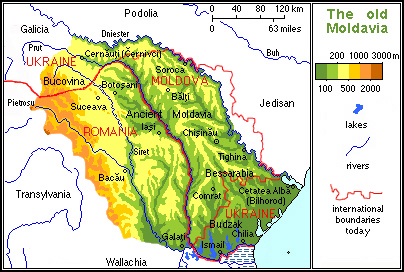|
Moldavian Plateau
The Moldavian Plateau (Romanian: Podișul Moldovei) is a geographic area of the historical region of Moldavia, spanning nowadays the east and northeast of Romania, most of Moldova (except the south), and most of the Chernivtsi Oblast of Ukraine (where it is known as the Pokuttian-Bessarabian Upland[1]). Limits The Moldavian Plateau is bounded (in clockwise order), as follows.
The Moldavian Plateau comprises over two-thirds of the territory of the medieval Principality of Moldavia, with the Eastern Carpathian Mountains and the Bugeac Plain representing the remaining part. This fact is the origin of the name of the plateau. This geographic area (including Eastern Carpathians and the Bugeac) is also called (especially by historians) the Carpathian-Dniester-Pontic region, or the Carpathian-Dniester region, since it is bounded by the Carpathians to the west, by the river Dniester to the north and east, and by the Black Sea (Pontus Euxinus) and the Danube to the south-east and south. GenesisThe Moldavian Plateau was formed at the end of the Neogene through sediments, over an old continental platform, the East European Platform. Afterwards, the settled sediments, which were brought in by rivers from the Carpathian Mountains, were modeled by the elements giving the plateau its current aspect. The materials that formed the sediments are gravel and sand. Hardened, they formed gritstones. All over the plateau, the latter are interspersed with clays, or badlands, which produce landslides or other natural hazards.[2] The slope of the terrain follows the direction of the rivers: from northwest to southeast. Along them, the altitude decreases from 700 m (2,300 ft) to under 200 m (660 ft). The strata are disposed in North-South and northwest-southeast aligned layers, producing asymmetric valleys and ridges. Among the latter are the steep edge of the Bârlad Plateau (Romanian: Podișului Bârladului), known as the Iași Ridge (Romanian: Coasta Iașilor), the edge of the Central Moldavian Plateau (Romanian: Podișul Moldovei Centrale), known as the Cornești Hills, and the edge of the Dniester Hills, known as the Dniester Ridge. The relief in the valleys of the rivers and creeks is quite conspicuous, so that the valleys have large terraces and hillocks. The Siret Passage (Romanian: Culoarul Siretului), ramified in the north with the Moldova Valley, and Suceava Valley cuts the main part of the plateau from the Moldavian Subcarpathians. The Prut Passage cuts the Plateau in half in the north-south direction. The Dniester Passage bounds it from the Podolian Plateau and the Pontic Plain. Its ramification Răut Passage separates the main part of the Moldavian Plateau from the Dniester Hills CompositionThe Moldavian Plateau comprises several distinct regions:
ClimateThe climate of this plateau is transitional Temperate Continental. Overall, the altitude affects the climate, with annual mean temperatures in the Suceava Plateau ranging between 6 °C (43 °F) and 8 °C (46 °F) and precipitation of 500 millimetres (19.7 in) to 800 millimetres (31.5 in) per year and, with annual mean temperatures of 8 °C (46 °F) to 10 °C (50 °F) and precipitation of 400 millimetres (15.7 in) to 500 millimetres (19.7 in) in the Moldavian Plain or Bârlad Plateau. The main influence on the climate is Dry Continental with frequent cold north winds in winter. In the Suceava Plateau and the Dniester Hills, there is an influence of Scandinavo–Baltic climate with the circulation of masses of polar air in the winter. WatersStreams on the plateau flow into the Siret, Prut, or Dniester rivers. The Prut has the Jijia as its principal tributary. The Siret traverses and—with the exception of the Subcarpathians—limits the Moldavian Plateau The lack of precipitation has required water management in the Jijia Plain and in the Bălți steppe which serves as a reservoir and for fish farming; Lake Dracșani is the largest of these. Other bodies of water are the rivers Siret and Prut (Lake Stânca-Costești, Lake Dubăsari), in the Siret Passage. Natural resourcesThe Moldavian Plateau holds hydrocarbon resources (petroleum and the associated gases), which are extracted in the southwest portion. In the northwest are found Romania's most important reserves of kaolin (china clay), extracted and used to produce porcelain. Hemp is cultivated in the Suceava Plateau, cereals and wine grapes (Vitis vinifera) in the Jijia Plain, Bălți Steppe, Bârlad Plateau, and the Central Moldavian Plateau. In the Siret Passage they cultivate potatoes and sugar beets. FaunaCharacteristic of the plateau are mammals such as goats, wild boars, wolves, foxes, European wildcats, lynxes, badgers, and hares. Birds include black grouse, woodpeckers, cuckoos, pheasants, quails, hawks, owls, and fish include perch and the carp-like barbel. References
External links
|
Portal di Ensiklopedia Dunia